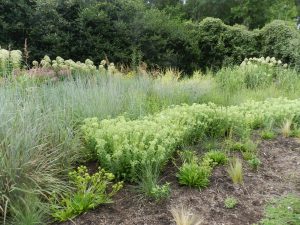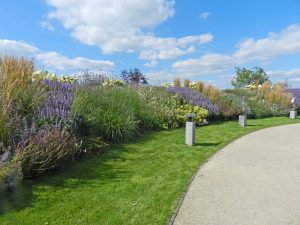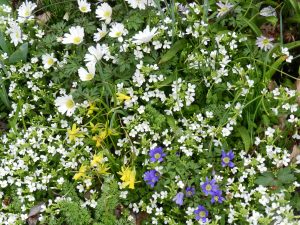
1998 Plant Delights Spring catalog – always entertaining as well as enlightening.
It’s that time of year and our mailboxes are starting to fill with seed and plant catalogs. So we start reading and dreaming about this coming year’s garden.
This winter, I will be speaking several times about perennial garden design. Many of you love color and the idea of a perennial garden but don’t want to spend a lot of time taking care of the garden. Therefore, I would like to suggest some perennials that virtually take care of themselves.
When designing such a garden, what attributes are we looking for? We want high performance (thus long bloom), more than one season of interest, little deadheading, and no staking. Many perennials and ornamental grasses offer long seasons of interest although not necessarily bloom color, colorful or texturally interesting foliage, movement, fragrance, seed heads or pods, and winter interest.

Asclepias tuberosa shown in combination with other low maintenance perennials
(Astilbe deadheads, Vitex agnus-castus ‘Abbeville Blue’, Sedum, Rudbeckia missouriensis, and Eupatorium fistulosum) on New York’s High Line.

Asclepias tuberosa ‘Hello Yellow’ with Larkspur in my garden.

Asclepias tuberosa pods
An example of a perennial with many of these characteristics is Asclepias tuberosa (Butterfly Weed). If the color orange is not one your favorites, try using the cultivar ‘Hello Yellow’ which is golden yellow. It is in bloom for six to nine weeks in July and August, has interesting seed capsules in late August and September, needs no staking, is a magnet for pollinators (particularly Monarch butterflies), and needs only to be cut to the ground in early spring. If seeding is not desired, the capsules should be removed before splitting open. However, this is the perfect perennial for a naturalistic design. Hardy to zone 4, this perennial will thrive in full sun and in average to dry soil.

In July and August, at the display gardens of Hoffman Nurseries in North
Carolina, the green heads of Sedum ‘Autumn Joy’ are the shortest part of a layered
composition of Eupatorium ‘Bartered Bride’, Eupatorium fistulosum, and Sorghastrum nutans ‘Stainless Steel’.

In late August, at New York’s High Line’, the heads of Sedum ‘Red Cauli’
turn rosy pink, this time acting as a textural foil for Silphium laciniatum (Compass Plant) and Sporobolus heterolepsis both hardy to zone 3
One of my favorite perennials for constant change is the upright Sedum (Stonecrop). Best known is ‘Autumn Joy’, a rusty red, but I frequently use ‘Neon’ because it is pink, is a bit shorter (12” instead of 18”), and doesn’t flop as much. This is another zone 4 hardy perennial for hot, dry spaces. The early spring rosette is attractive with its succulent leaves but stonecrops really come into their own starting in July when they resemble short heads of broccoli. Sadly, the deer also like upright sedums.
If you have large areas where masses of plants can be used, they could be arranged somewhat naturally, as in drifts which feather in and out of each other. This is particularly useful on a slope that would be very difficult to mow. Because large properties often consist of several beds or long beds, repetition is an easy way to unify them. This can be done by using a specific plant in many of the beds, by using a particular form such as pyramidal or mounding, by using a specific texture like that of grasses, or by using one color with groupings of one genus or several different genera that all have that color bloom or foliage. Ornamental grasses are a natural for this type of repetition.

In this long bed at a German display garden, groupings of Calamagrostis ‘Karl
Foerster’ are used repeatedly as punctuation marks.
Calamagrostis acutiflora ‘Karl Foerster’ is an ornamental grass that I often use for its early foliation and long bloom. Hardy to zone 4, this grass, when in bloom, has a very stiff, linear form that provides great contrast to the looser form of many perennials such as Agastache ‘Blue Fortune’ (hardy to zone 5, possibly zone 4). Plant in full sun even though many books and catalogs say partial shade will do; in partial shade, it will lean or flop. Cut to the ground in very early spring.

Ligularia dentata is used en masse at the bottom of a shady slope
For partially shaded, moist areas, Ligularia dentata or stenocephala cultivars are an excellent choice. The foliage is just as important as the flowers, adding interest to the garden from the minute it appears until frost. These leaves are large, rounded, often serrated and can be green or bronze or purple. The blooms are either golden yellow daisy-like flowers or clear yellow tall spikes. Given optimum conditions (moisture), prolific seeding will occur, meaning that the area will fill in quickly. The flower stalks remain upright throughout the winter and are very attractive when covered with snow. Merely cut to the base in spring. If you wish to prevent seeding, cut down the stalks before the pods open.
Beds are frequently bare during the winter. When searching for evergreens to supply some winter color, don’t forget about evergreen perennials, many of which make excellent groundcovers for slopes and don’t have to be wrapped with burlap which defeats the reason for using evergreens.

Get double duty from the same space by interplanting the tiny bulb Anemone blanda,
both blue and white, plus Narcissus ‘Tiny Bubbles’ that will push up through the Arabis
foliage.
An excellent but sadly neglected evergreen perennial groundcover is Arabis caucasica (Rock Cress). Hardy to zone 4, its multiplicity of small, six to twelve-inch high, white flowers in May cover the foliage and bring smiles to people’s faces. There are some rosy-pink cultivars as well. The fuzzy foliage is only an inch high but clambers over the ground quickly. Excellent drainage in full sun is essential to prevent winter rot. For extra spring color, you can plant tiny bulbs like Anemone blanda and dwarf narcissus between the sprigs of Arabis.
Many perennials and grasses are relatively low maintenance, particularly the grasses that only need to be cut down once a year in early spring (not Festuca or Helictotrichon). You can lower maintenance with careful plant selection but you need to know that there is no such thing as no maintenance.
There are many more perennials and ornamental grasses that are just as useful as the ones I have highlighted for high performance and low maintenance. Perhaps I’ll find another opportunity to discuss some of them.


0 Comments